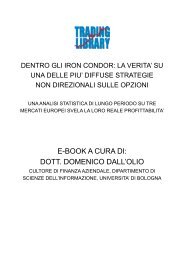o_18t8444k2t2f3fhftv922768a.pdf
You also want an ePaper? Increase the reach of your titles
YUMPU automatically turns print PDFs into web optimized ePapers that Google loves.
Foreword<br />
Option traders have an advantage over other<br />
investors because they can structure positions<br />
that generate a profit regardless of the direction<br />
of movement of the underlying security. Many of these<br />
trades generate their maximum profit if the underlying<br />
stock remains motionless for an extended period of<br />
time. Condor is such a trade. Simply stated, condors<br />
generate large profits when the underlying security<br />
remains range-bound for the duration of the trade.<br />
Properly structured condors can absorb large market<br />
changes and still generate impressive profits.<br />
This characteristic has made condors one of the<br />
most popular trades among knowledgeable investors<br />
who have discovered the benefits of not betting on the<br />
direction of anything. Their view is exactly opposite<br />
that of a stock picker who spends all his time searching<br />
for “underpriced” securities that can be purchased<br />
below fair value. Condor traders assume that the market<br />
knows the fair value of a stock or index, and that it<br />
will continue to trade close to the current price until<br />
additional news generates a distinctly different view.<br />
Moreover, because option prices are based on volatility,<br />
they normally comprehend the effects of such news. A<br />
knowledgeable option trader, therefore, should be able<br />
to structure profitable condors in most markets.



